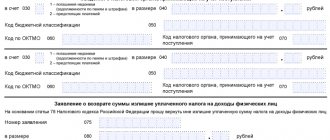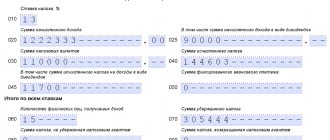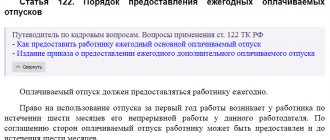The legislation regulates certain types of income of citizens, which are deducted from the total amount for taxation. Tax deductions are not subject to the usual personal income tax rate of 13% if they are standard.
Amounts deducted for children are standard tax deductions. This means that this form of reducing the tax burden will be in effect continuously as long as the original status of the taxpayer is maintained (in this case, receiving taxable income and the presence of one or more future heirs).
To whom can this deduction be made?
Article 218 of the Tax Code of the Russian Federation prescribes the procedure for assigning and calculating tax benefits, including “children’s” deductions. According to the law, the child tax deduction is an amount of money designated in regulations, from which the 13% personal income tax (income tax) will not be charged.
Each has the right to make this deduction :
- the child's natural parents;
- adoptive parents;
- guardians;
- trustees.
The right to receive this tax benefit is recognized if there are one or more offspring under the age of 18 or older (up to 24 years), if the eldest child is a full-time student as:
- student;
- cadet;
- intern;
- graduate student;
- resident.
FOR YOUR INFORMATION! Full-time education is allowed not only in an educational institution in the Russian Federation, but also abroad. Studying a master's degree as a first higher education will not be an obstacle to assigning a tax deduction (naturally, if the child meets the age criterion).
Regardless of age, a separate tax deduction will be accrued for disabled children.
Termination of the “children’s” deduction
Stop giving deductions when one of the following conditions occurs:
| Condition | Month from which no deduction is allowed |
| The employee's income exceeded RUB 350,000. | Month in which the employee's income exceeded the limit |
| The child has turned 18 years old | January next year |
| A full-time student, graduate student, resident, intern, student is 24 years old. The child did not stop studying until the end of the year | January next year |
| A full-time student, graduate student, resident, intern, student is 24 years old. The child stopped studying by the end of the year | Next month after graduation |
| Full-time student, graduate student, resident, intern, student who stopped studying before reaching 24 years of age | Next month after graduation |
First, second, third... How much do we subtract?
The tax deduction is assigned separately for each child who meets the age criteria. For a child born first or second, it is the same amount, namely 1,400 rubles. If the taxpayer is in the care of three or more children or older children eligible for deduction, then for each offspring younger than the second, a deduction in the amount of 3,000 rubles will be charged. The amounts allocated for each of them are added up.
The number of children is counted according to seniority, that is, in the chronological order of their birth. In this case, the age of the older children and their status are not important. For example, the oldest is already over 18 and is not a full-time student, that is, he is not subject to a tax deduction, and there are only three children in the family. In this case, the youngest, who has not reached this age, is still the third child, who is entitled to a deduction in a larger amount - 3,000 rubles.
IMPORTANT! In tragic cases of death of children, their number according to seniority does not change: every living child still continues to be considered the same in number as he was at the moment of birth. If spouses have new children in another marriage, they will no longer be considered the first: the chronological order of birth is preserved.
A disabled child has the right to make a deduction within the following limits:
- 12,000 for each of the parents (natural or adopted);
- 6,000 (for guardians and trustees).
NOTE! The amounts given are not the money that will be returned to the taxpayer with children. These funds simply will not be charged the additional 13% due to personal income tax. For example, a citizen with two minor children will receive a tax benefit (1400 + 1400) x 0.13 = 364 rubles. This amount will make his tax burden lighter.
Users of the official website of the Federal Tax Service have the opportunity to independently calculate tax deductions using the online service. To calculate, you will need to enter the initial data in special fields:
- amount of children;
- the amount of taxable income for the previous period;
- data regarding children with disabilities.
Children's deductions and the principle of their application
Deductions for children are as follows:
Features of calculating the deduction amount:
- Deductions for disability and the number of children are summed up. For example, if the second child has a disability, then the amount of the deduction for him will be: 1,400 12,000 = 13,400 rubles.
- Children are counted according to the order of birth, and not according to the deductions provided. Example: deductions are allowed for three children: 1,400 1,400 3,000 = 5,800 rubles. If the first child has reached the age of 18, then no deduction is provided for him, but the third child did not become the second because of this and the deductions are calculated as follows: 1,400 3,000 = 4,400 rubles.
Let us highlight the nuances that should be taken into account when writing an application for a tax deduction.
Double deduction amount
The law gives the right to certain categories of citizens to make a “children’s” tax deduction, doubled. If a child is being raised by a single mother, she has this right unconditionally (just like a father raising a child alone). Any parent can refuse to receive the child deduction due to him, then his share of this tax benefit will go to the other parent. If the child is adopted, then if one of the adoptive parents refuses the deduction, the other will receive it double.
When there is only one parent
There is no term “sole parent” in legislative acts. A single mother (less often a father) is considered the only parent by law if this is proven in the following documents:
- the second parent is not listed on the child’s birth certificate;
- The registry office issued a certificate (form 25) that information about the second parent was recorded in the certificate from the words of the first (most often the father is entered from the words of the mother);
- the second parent has died, for which there is official medical evidence;
- the second parent is officially deprived of parental rights;
- there is a court decision declaring the second parent dead or missing.
ATTENTION! An unregistered marriage cannot be grounds for recognizing a parent as single.
If a single parent registered a marriage, he will no longer be entitled to receive a double tax deduction, since he is no longer the sole caregiver of his child. But the new spouse automatically acquires the right to this benefit.
The limit set for income when calculating deductions
A large income removes from citizens the right to tax benefits for having children. If the amount of a citizen’s income exceeds that established by the state, he himself has the financial ability to be responsible for providing for the child, so there is no reason to reduce his tax burden. Until 2016, citizens who received more than 280 thousand rubles were not able to apply for a child tax deduction. In 2016, this amount was changed, and today it is 350 thousand rubles.
The time for which the income received is calculated begins to be taken into account from the beginning of the tax period, namely the calendar year. As soon as the accrual amount in a particular month has reached the legal limit, the deduction will no longer be accrued for subsequent months.
Documents for child tax deduction
If the child’s parents are officially employed, then their employer himself submits the necessary papers to the relevant tax authority. Citizens will simply receive wages in accordance with all taxes withheld and deductions made. The necessary documents are provided by employees to the human resources department or accounting department at their place of work.
For a standard “children’s” tax deduction you will need:
- birth or adoption certificates (for all children);
- an application in which the employee requests a standard tax deduction for the child(ren);
- certificate 2-NDFL for the previous year (if the place of work was changed);
- for children who are already 18 years old - a certificate stating that they are actually studying full-time at a particular educational institution (this certificate must be updated annually).
ADDITIONALLY! If the parents are divorced or their marriage has not been registered, then the second parent can receive a deduction if he documents that he is involved in providing for his offspring: for this he needs to provide an agreement on the payment of alimony or a certificate of registration at the same place of residence as the child. A court decision on determining the person with whom the child remains in the event of a parental divorce is also valid.
For a “double” deduction, the following is added to these documents:
- application for a double tax deduction;
- written refusal of the other parent or adoptive parent;
- Certificate 2-NDFL of the parent who wrote the refusal (for each month for which the deduction is made).
Size in 2022
In 2022, parents can receive a tax deduction for a disabled child. This benefit is different for each parent, as it consists of two amounts:
- 12,000 rubles per disabled child for adoptive parents or parents. If guardians or adoptive parents want to take advantage of the deduction, then the amount is reduced to 6,000 rubles .
- The second amount depends on how disabled the child is in the family. For the first and second = 1400 rubles , and for the third = 3000 rubles .
The listed amounts are subtracted from the employee’s income before taxation, since 13% is not deducted from the standard deduction amount. To understand this, let's look at an example.
Example:
The citizen has three minor children, the third of them is disabled. He wrote an application for benefits for each child.
This month he received a salary of 50,000 rubles.
The total amount of the required tax deduction for all children is calculated as follows = 1400+1400+3000+ 12000 = 17800 rubles.
The personal income tax amount will be: (50000-17800) * 13% = 4186 rubles.
If there were no benefits, then the personal income tax amount would be calculated as follows: 50,000 * 13% = 6,500 rubles. As we can see, the employee is returned 2314 rubles (6500-4186).
The second parent of a disabled person can take advantage of the same right if he has a monthly salary from which taxes are withheld.
Double size
, guardian, adoptive parent or trustee
can receive a double deduction for a disabled person under personal income tax A citizen can receive this status if the second parent has died or is considered missing. If such a citizen gets married, then he cannot take advantage of the double benefit. In the event of a divorce, the employee can file it again only if the last spouse did not adopt the child.
The second case when you can get a double benefit is when one of the spouses renounces their right . It is impossible to refuse such a benefit if a person does not work, is on the labor exchange, or has taken out maternity leave for up to 1.5 years or for maternity leave.
more about how to write an application for a double child deduction here.
Taxpayer liability
The employer assumes all obligations for submitting documents to the tax office, calculating and accruing due payments, including tax deductions. This obligation is provided for by the function of a tax agent that the employer performs in relation to employees.
But the employer carries out all its actions based on information and documents received directly from the employee. If the employer fulfilled his duties in good faith, and then it turned out that the employee provided false data and/or fictitious documents, liability for such an act (and sometimes criminal liability) will fall on the taxpayer himself - the hired employee, and not his employer.
From what time is the deduction calculated?
The calculation period is considered to be a calendar year, so the tax benefit regarding the income tax deduction for children will be accrued from the beginning of the year. This does not take into account exactly what month the application, declaration and the rest of the documents were submitted to the tax authority.
2017 made some adjustments: now the beginning of the year for calculating deductions will be counted from the month in which the child was born, or from the day when he was adopted or guardianship was established. If an employee who has children is employed while already having them, the new employer will begin to count the required benefits starting from the month of employment, taking into account the income received directly at the new place.
Income limit up to which you can receive a deduction
In addition to restrictions on the age of children, the legislation established an income limit, upon reaching which the deduction will no longer be provided. From the month in which your income from the beginning of the year exceeds 350,000 rubles , you will not be able to receive a deduction.
Example: Savatieva E.A. two minor children. Salary Savatieva E.A. is 80,000 rubles. per month. Thus, she will be able to receive the standard deduction for children for four months (80,000 x 4 = 320,000 rubles). Based on the results of the fifth month, the income of Savatieva E.A. will exceed 350,000 rubles. (80,000 x 5 = 400,000 rubles), which means she will no longer be able to receive the standard deduction.
For more information on income limits, see the article: “Income Limits.”
Didn't receive the required deduction?
It happens that a taxpayer, for one reason or another, during the year did not receive the tax benefit due to him for his children. Or maybe this deduction was not fully accrued to him: tax agents also make mistakes. This does not mean at all that the possibility of deduction is lost for him.
In the coming year, he has the opportunity to return part of the amount in the amount of a deduction from the tax already paid.
The main thing is to timely submit your tax return and the required documents for a personal income tax refund:
- birth or adoption certificate (copies) for each child;
- Form 3-NDFL (declaration);
- for a son or daughter from 18 to 24 years old - a certificate of in-patient education.
How to get it through the tax office?
If a citizen did not know that he had the right to receive a benefit and did not write an application at his place of work, then he can receive a deduction from the tax office.
To do this, you will need to provide the following documents to the Federal Tax Service at your place of registration :
- Declaration 3-NDFL - you can fill it out for free in a special program on the Federal Tax Service website.
- Certificate 2-NDFL from the place of work.
- Copies of passport.
- Medical certificate of disability.
- Birth certificate of a disabled child.
- Certificate of family composition.
- Bank account to which over-withheld personal income tax should be transferred.
These papers can be sent by mail or brought to the inspection yourself. In order to get your money back for last year, you need to submit documents before April 30 of the current year.
Final deadlines for deductions
If a child turns 18 this year and is not in full-time education, the standard tax deduction will be due until the end of that calendar year (month of birth does not matter).
A full-time student under 24 years of age will give the right to a deduction to his parents for the following period:
- until he graduates from educational institution (even if he is not yet 24 years old);
- until the year of your 24th birthday (even if training is not completed).
NOTE! In the tragic event of the death of a child, the reduced tax rate remains with the parents until the end of the calendar year.
Application for a deduction
It is best if the enterprise has ready-made application forms in which you only need to enter individual data, and the necessary deductions will be required, then none of them will be forgotten.
However, a free form of application is also allowed, because there are no strictly established samples in this regard.
Sample application for the standard child tax credit
To the director of Domostroy LLC from storekeeper R.L. Rozanova.
STATEMENT
When determining the tax base, I ask you to provide me with monthly standard tax deductions for personal income taxes for my children A.D. Rozanov. (21 years old, full-time student), Rozanova O.D. (10 years).
I am attaching to the application:
- a copy of O.D. Rozanov’s birth certificate;
- a copy of A.D. Rozanova’s passport;
- certificate stating that Rozanova A.D. actually studying full-time at Moscow State University (Faculty of Economics).
01/14/2015 R.L. Rozanova






